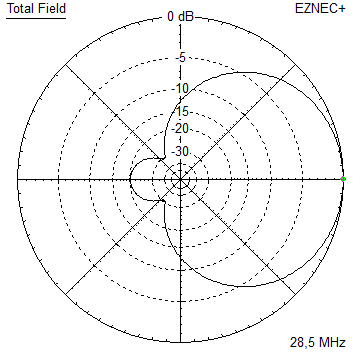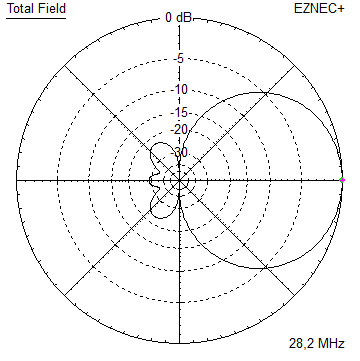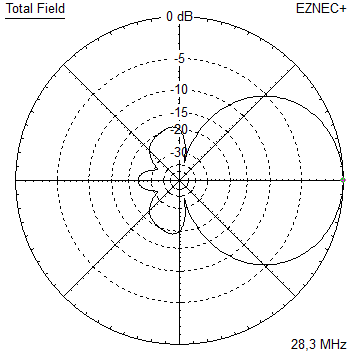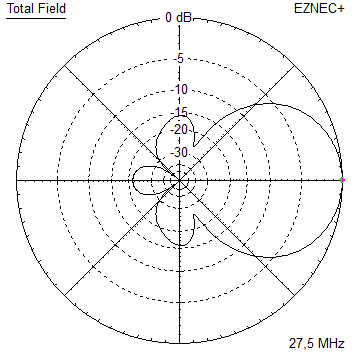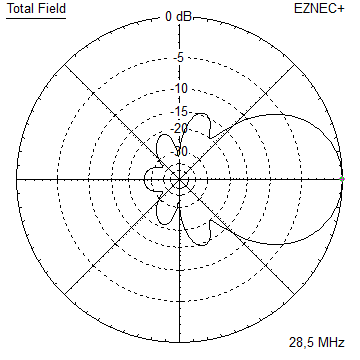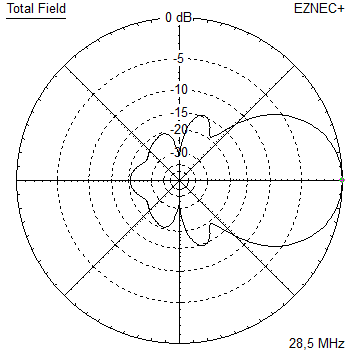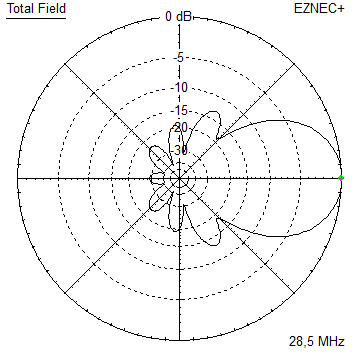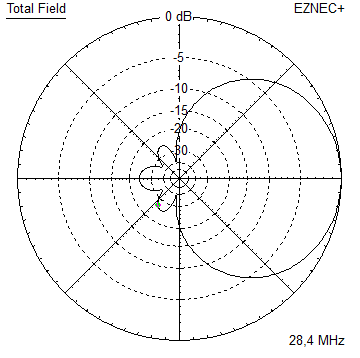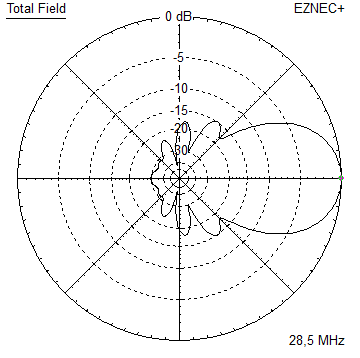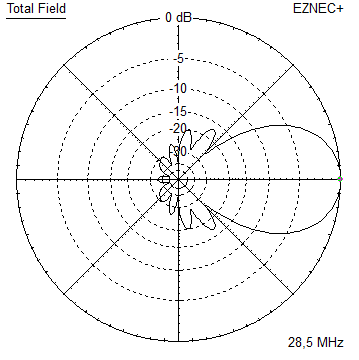
YBN 28-5w Yagi with straight split Dipole
CW + SSB band 28.0 to 28.5 MHz - 28 ohms version
On 28 MHz we should less look for gain but very clean directivity, because if the band is open successful DX more or less comes down to fade out unwanted signals. If we can easily produce a signal that enables us to ping our own echo when twice (!) around the globe with less than 100 watts of output, we may pass on 0.5 dB gain. And when band is closed that little bit would not help at all.
The patterns scattering factor (dt.: Streufaktor) as ratio of all rear and side lobes against the beam lobe is what we should look for in first place. Next we want forgiving behaviour according element length and tuning since shortwave Yagis are hard to post-tune on the pole and an exact taper factor.
Current distribution

Performance Data
Gain vs. isotr. Rad. 10.1 dBi Gain vs. Dipole 8.0 dBD -3 dB E-plane 55.2 deg. -3 dB H-plane 74.4 deg. F/B -28.8 dB F/R -22.6 dB Impedance 28 ohms Mechan. Length 7626 mm Electr. Length 0.72 λ Stacking Dist. h-pol. (28.3 MHz) top-to-bottom 8.76 m or 28.7 ft side-by-side 11.43 m or 37.5 ftGeometry
Pos. 1/2 Length
in NEC
Refl. 0 2620
DE 1220 2575
D1 2070 2490
D2 4221 2390
D3 7626 2215
ele. 20 mm
Driver an element diameter is 20 mm. No taper applied.
Use EZNEC's Auto-Segmentation at 28.2 MHz.
Drawing - to scale - except tube diameters and brackets

Building hints
Use L-profile brackets (see below), use U-bolts to clamp on boom and elements Given most short wave beams have to last very long on the mast I consider metal clamps and bracket compensation a good method.
Use Stauff-clamp OR thick walled plastic tube plus U-bolts for DE centre point.
Tapering Elements
Boom: tube Ø 50 x 3 mm
Elements: tube Ø 20 x 2 mm on middle section
tube Ø 16 x 2 mm on both sides
YO taper - lengths are per side
Bracket Ø 20 Ø 16 total span
Refl 135 1365 1186 2 x 2686 = 5372
DE 135 1265 1241 2 x 2642 = 5284
D1 135 1165 1255 2 x 2555 = 5110
D2 135 1165 1154 2 x 2454 = 4908
D3 135 1065 1077 2 x 2277 = 4554
Tube cutting table
tube Ø 20 tube Ø 16
Refl 3000 1186 + 200 = 1386 (2 pcs.)
DE 2800 1241 + 200 = 1441 (2 pcs.)
D1 2600 1255 + 200 = 1455 (2 pcs.)
D2 2600 1154 + 200 = 1354 (2 pcs.)
D3 2400 1077 + 200 = 1277 (2 pcs.)
Element brackets L-profile 80 x 40 x 3 mm, l = 270 mm.
use U-bolts for 20 mm and 50 mm, the 50 mm ones with blocks.
(see DL4AAE, 4-Element-Yagi für 28 MHz, CQ-DL 12-2012
A note on tapering history
Read Joe Reisert, W1JR, Yagi/Uda Antenna Design, Part 1: A different approach, Communications Quarterly - Winter 1998
commenting on the Lawson, W6QHS methode
"Tom Ring, WA2PHW, and Brian Breezley, K6STI, came up with an even better scaling and
tapering solution. Remember that when you scale or taper an element, you are essentially
trying to come up with an element that has the same electrical impedance at the new
frequency. What Ring and Breezley did was to adjust the element lengths after scaling
and tapering for the same electrical impedance using the YO (Yagi Optimiser) program."
Pattern and VSWR Plots
Elevation and Azimuth plot at 28.2 MHz
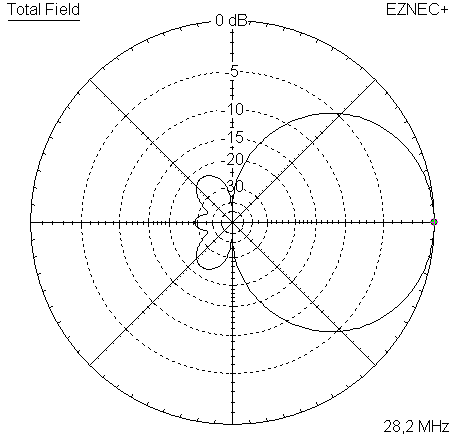
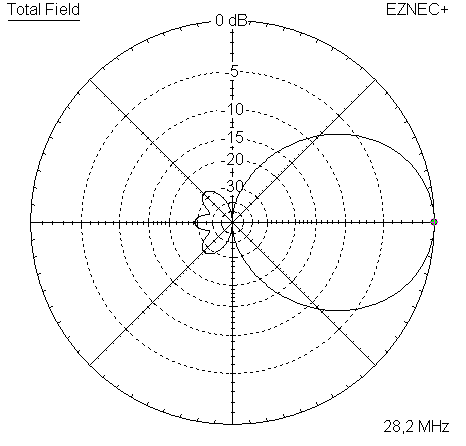
SWR and Return Loss plots - simulated with 4nec2 // Note the 100 dB scale
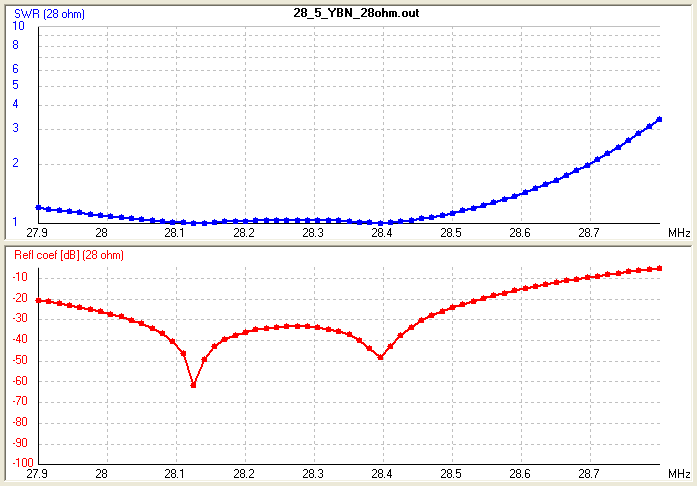
Downloads
EZNEC file of this Yagi
or simply the NEC input file
How to match to 50 ohms
1. Coax match
You may use the classic DK7ZB match. Go to http://www.mydarc.de/dk7zb/start1.htm and look for details.
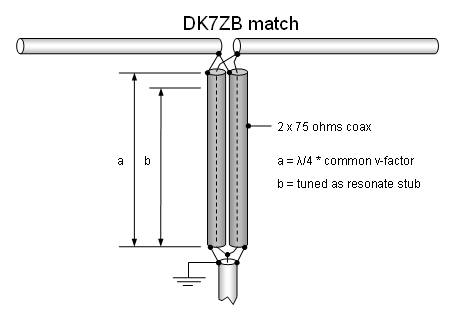
Use a quality coax like the Ø 5 mm RG 302 B/U with PTFE dielectricum. (http://www.kabel-kusch.de)
2. Transformating quarterwave tube line

Copper tube (plumbers heating pipes) inner tube Ø 10 mm, outer Ø 20 x 1 => Øi 18 mm results in Z = 35.3 ohms inner tube Ø 15 mm, outer Ø 28 x 1 => Øi 26 mm results in Z = 33.0 ohms Length is 2657 mm roughly
How to find precise numbers? => see on my Coax Line Imp. & Splitters Online Calculator page
Stacking
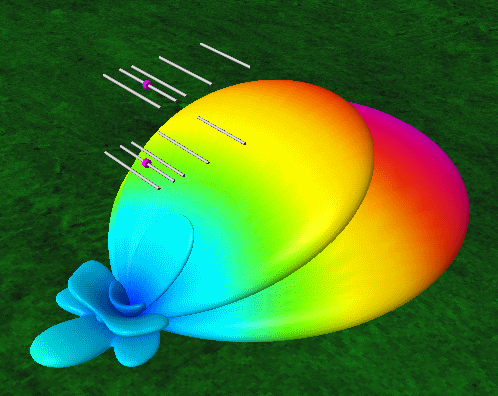
Note the good back lobe supression at that small distance. Mind this is short wave.
Signals may intrude from all angles.
Elevation plot and data of 5 over 5 array at 5.5 m stacking distances: free space / perfect gnd

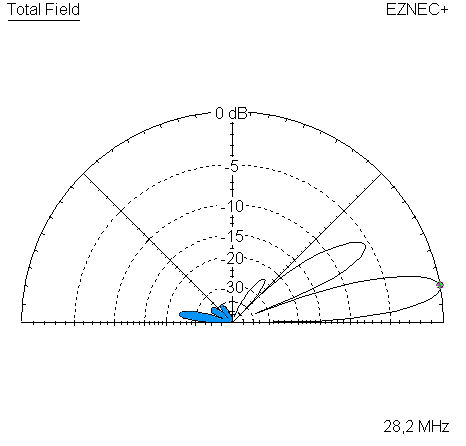
free space perfect gnd
Gain vs. isotr. Rad. 12.2 dBi 17.6 dBi
Gain vs. Dipole 10.0 dBD 15.4 dBD
-3 dB H-plane 55.8 deg. -
-3 dB E-plane 44.8 deg. -
F/B -22.8 dB -
F/R -22.8 dB -23.5 dB
Elevation plot and data of 5 over 5 array at 8.5 m stacking distances: free space / perfect gnd
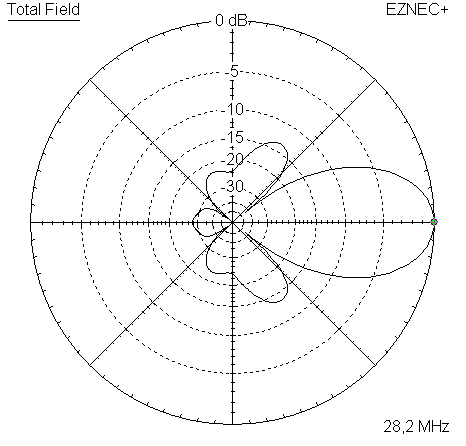
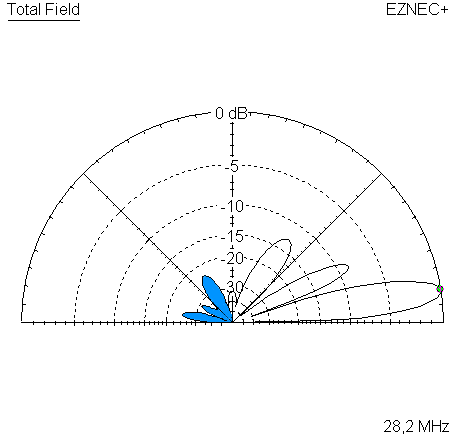
free space perfect gnd
Gain vs. isotr. Rad. 12.9 dBi 18.1 dBi
Gain vs. Dipole 10.8 dBD 15.9 dBD
-3 dB H-plane 55.8 deg. -
-3 dB E-plane 33.4 deg. -
F/B -27.8 dB -
F/R -22.7 dB -23.2 dB
73, Hartmut, DG7YBN
